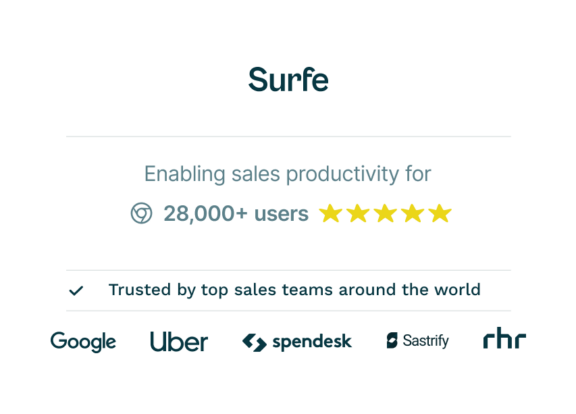How to Set Sales Targets That Align with Business Growth Goals

Imagine you’re playing a game of football.
You see a perfect opportunity to score. You pass to your teammate, and they shoot…in the opposite direction, at a totally different goal? What?!
Well, that’s exactly what happens if your sales team isn’t working towards a common objective. If you all have different targets in different places, how do you know who’s doing well? Or even what doing well is?
Here’s the thing: you need to set sales targets if you want your team to excel and contribute to business growth goals. And that’s exactly what we’re going to talk about today. We’ll be going through exactly how to get your team aligned by setting sales targets for 2025:
- Assessing Your Current Sales Performance
- Setting Sales Targets That Align with Business Objectives
- Linking Sales Targets to Broader Growth Strategies
Get your boots on – it’s time to start shooting for the right goals 👇
Understanding Sales Targets and Their Role
Just in case it’s the first ever day of your job: what is a sales target?
Simply put, it’s a goal set with the intention of improving your, and your team’s, performance.
That definition is a good place to start – but it’s worth keeping in mind that it’s also got to contribute to your business’s goals. Think about it: if your strategy is to go after a select group of high-value accounts, ABM-style, you’re hardly going to have a sales target like making 500 cold calls a day. See what we mean?
To carry on with this example, let’s say you’re an SDR tasked with making 500 cold calls a day. To reach such a wide range of people, you end up having to target people who don’t exactly match your narrow ICP. The AE’s struggle to close deals, everything grinds to a halt, and the business starts struggling.
It’s super important to make sure that your goals are relevant to what the business needs to succeed. Simple!
These KPIs might be (to use a few common illustrations): higher conversion rates, a shorter lead-to-close time, and a larger average deal size.
Got it? Good.
Assessing Your Current Sales Performance
So, we now know that part of goal setting is improving performance. And to improve performance, you have to know how you’re performing right now (and water is wet, we know). 💦
To do this, you need to get very familiar with your historical sales data. What areas really need improvement? Where could your team do even better than they’re already doing?
Key metrics to take a look at here include: lead conversion rates, pipeline velocity, and sales quota attainment rates.
Your CRM is going to be super helpful here – you probably already have a dashboard that tracks key metrics. From here, you should be able to tell at a glance what’s going well, and not so well.
Once you’ve identified the gaps, or to put it a bit less politely, where your team’s underperforming, you’ll know where best to set your goal.
Setting Sales Targets That Align with Business Objectives
Who’s heard of the SMART goals framework? We’ll hazard a guess and say you probably have – but as it’s a classic goal-setting framework that actually drives results, we’re going to run through it quickly here.
When setting targets, you want them to be SMART: Specific, Measurable, Achievable, Relevant, and Time-bound.
Let’s break these down:
- Specific: what do you actually need to achieve? Who’s going to do it?
- Measurable: how do you know what success looks like?
- Achievable: setting unrealistic targets = failure to move the needle where it matters. No thanks.
- Relevant: what targets make sense for your unique business goals?
- Time-bound: setting a target is all well and good, but you don’t want to be working towards the same one in five years’ time.
Let’s take a basic example. A SMART goal might be:
“I need to increase the number of deals of X size (specific) I close by 10% (measurable), which I’ll do by targeting this new, full-of-potential sector (achievable). Because deals of this size tend to be easy to upsell later down the line, increasing the amount of them will contribute to short- and long-term business growth (relevant). I will hit this target in six months’ time (measurable).”
Strategies to Make Hitting Targets Easier
Hitting targets may not always be easy, but there are several strategies you can employ to help things along.
Using Market Insights
Keeping an eye on market trends and buyer behavior helps you 1) make sure your goals are the right ones and 2) hit them more easily. For example, if you know that buyers in your industry are interested in AI, and you happen to be selling an AI tool, you might want to stretch your goals. Or, you might notice that everyone’s hopping on a new digital channel or tool – so naturally, you do the same to reach your buyers where they’re at. Filling your CRM with behavioral data is a good shout if you want these kind of insights.
Getting Your Team Involved
Suddenly being hit with a crazy sales target can feel a little jarring, even to the most seasoned of sales professionals. If you approach setting targets as a group exercise, you’re far more likely to get the team brought in and motivated from the get-go – plus, they’re likely to have some insights that will make the target-setting process much easier, too.
We’ve now chatted a lot about targets. Let’s talk about how to link them to broader growth strategies.
Linking Sales Targets to Broader Growth Strategies
First things first, you want to look at the bigger, meatier goals that the whole business is working towards – and then work backward to decide what targets you should be setting. Let’s take a look at a few examples:
Revenue Growth Goals
Say you’ve got a hefty quarterly or annual revenue goal to hit. You might decide to set a target around lead quality (how many SQLs come in a month, for example), and decide to get there by doubling down on lead nurturing and segmentation strategies.
Customer Retention and Upselling
It costs five times as much to attract a new customer rather than retain one – with that in mind, it’s easy to see why retention is big business for a lot of companies in the B2B space. And that’s before we’ve even mentioned upselling opportunities 😉. If that sounds like it could be good for your business, you might want to set targets around retaining existing customers and identifying upsells.
Helpful tip: make sure you use tools like your CRM and AI to your full advantage. They’re your best friend when it comes to monitoring and achieving sales targets.
Extremely helpful tip: Surfe connects your CRM to LinkedIn, meaning any of the sales activity your team performs on LinkedIn is all synced, meaning your team is fully aligned and never stepping on each others toes.
Speaking of…
Monitoring and Adjusting Sales Targets
It’s super important to make sure you’re keeping an eye on how things are going: reviewing how you’re tracking against your targets, and getting regular feedback from all team members too.
That’s where KPIs (like sales cycle length or percentage of quota achieved) come in. They make it super simple to track progress at a glance.
It’s also worth noting here that you should adapt your targets in response to changing market conditions or business goals. For example, if there’s a sudden economic downturn (no idea where we got that example from), then you might want to trim down your targets to make sure you’re still in with a chance of hitting them.
Let’s Wrap It Up!
They shoot…they score!
Now that’s what happens when your team members are working towards the same targets, with the ultimate aim of moving the business closer to its goals. Assess your current performance and line it up with business objectives, before figuring out what targets you need to hit and how you’re going to hit them.
Before you know it, you’ll have a high-performing team that’s moving the business to where it needs to be. Yes please.

Got your boots on?
Before you get selling, you’ll need a tool like Surfe on your team. Try it now for free.
FAQs About Setting Sales Targets That Align With Business Growth Goals
What Are Sales Targets And Why Do They Matter?
Sales targets are measurable goals that guide your sales team’s efforts, such as achieving a specific revenue figure or closing a set number of deals within a timeframe. They matter because they make sure your team’s activities align with the broader business growth goals.
Without clear sales targets, teams can waste time on activities that don’t drive results or contribute to company objectives. When well-defined and realistic, sales targets boost motivation, track progress, and help identify areas for improvement.
How Can I Set Effective Sales Targets?
Effective sales targets follow the SMART framework: Specific, Measurable, Achievable, Relevant, and Time-bound. Start by identifying your company’s growth goals – whether it’s increasing revenue, shortening the sales cycle, or expanding market share.
Break these big-picture goals into smaller, actionable targets for your sales team. For example, if you want to grow revenue by 15%, calculate how many deals or upsells are needed to achieve this. Ensure targets are realistic based on historical data and market conditions. Communicating the “why” behind the target is also key, so you can show your team how their efforts contribute to the business’s success.
Lastly, use tools like your CRM to track progress and refine targets over time. SMART sales targets not only keep your team focused but also provide a pathway to measurable success.
What Metrics Should I Use To Track Sales Targets?
Tracking sales targets requires key performance indicators (KPIs) that align with your goals. Some common KPIs include:
- Revenue growth: Tracks how much revenue your team generates within a set period.
- Lead conversion rate: Measures how many leads turn into customers, reflecting sales efficiency.
- Quota attainment: Tracks the percentage of sales reps hitting their individual targets.
- Pipeline velocity: Evaluates how quickly deals move through your sales process.
Your CRM is an invaluable tool for monitoring these metrics in real-time. By analyzing data regularly, you can identify what’s working, where your team may be underperforming, and adjust strategies or targets as needed. This keeps you on course to achieve both short- and long-term growth objectives.
How Do I Align Sales Targets With Business Growth Goals?
Aligning sales targets with growth goals starts with understanding the company’s broader objectives. If your goal is revenue growth, for example, you might set sales targets focused on increasing deal sizes or shortening the sales cycle.
Work backward from your business goals to create smaller, actionable targets. Let’s say the company aims to grow its market share. A good sales target could be acquiring customers in a new industry or region. Similarly, if retention is a priority, set targets around renewals and upsells for existing accounts.
Get your sales team involved in the target-setting process. When everyone understands how their efforts contribute to the bigger picture, you create alignment, accountability, and motivation.
Why Is It Important To Monitor And Adjust Sales Targets?
Monitoring and adjusting sales targets is crucial to staying responsive to changes in the market, team performance, or business goals. Regularly reviewing KPIs, like conversion rates and quota attainment, gives you insights into whether your team is on track or facing challenges.
Market conditions can shift rapidly. Economic downturns, industry trends, or new competitors can impact your ability to hit targets. If you need to, adjust your targets to keep them realistic and achievable.


